Maximising TCO with the new Worthington bundles
Bulk Distribution: Maximising TCO with New Worthington Bundles
Industrial gas bundles have been around for decades, with few changes to standard design. Until Worthington Industries decided it was time to break the mold.
The new Max9 Bundle from the Columbus, Ohio-based global industrial manufacturing company features a distinctive steel frame, as well as a new cylinder configuration that boosts storage capacity by nearly a quarter while maintaining the traditional bundle footprint.

The result is a lower total cost of ownership (TCO), increased uptime on the factory floor, and simplified supply-chain logistics for end users, according to Mark Jackson, Worthington’s Director of Technology, Innovation and Digitalization for Europe. Other design improvements, he said, have also made the packs easier to use, more ergonomic and the lighter-weight, finished bundle more sustainable.
Worthington has partnered with Wystrach GmbH of Weeze, Germany, on this project, bringing together two experienced leaders in their respective spaces of cylinder design and manufacture, and gas-bundle system design and production.

Same footprint, more gas
Gabriele Zeilerbauer, Worthington Industries European Sales Director – Industrial Products, said, “Wystrach was the partner for our Worthington-designed bundle.”
Calculating your TCO
Regardless of the type of compressed gas or bundle that you use, or the end market you serve, a key metric is always total cost of ownership.
If your ultimate goal is cost savings, it’s shortsighted to focus solely on purchase price when acquiring high-pressure gas cylinders, notes Zeilerbauer. Because a typical cylinder will be in service for decades, it will incur substantial operational costs over its lifetime. Being aware of these expenses — and weighing them against short-term cost savings — is crucial for making a wise purchasing decision that will minimize TCO.

Worthington conducted a 15-year study to calculate overall ownership costs, and concluded that TCO for industrial gas cylinders is based on three main factors: cylinder weight, logistics, and maintenance.
Cylinder weight: Worthington produces the lightest-weight cylinders on the market, with its empty 50-liter, 200 bar steel cylinder weighing just 41 kg, which is at least 5 kg lighter than the rest of the market. Based on a projected 120 fillings over the 15-year period, 800-km round trips from filling center to delivery sites, and a fuel cost of €1.5 per km, the added cost per cylinder can be as high as €38.05.
Logistics: As for logistics, having to schedule more trips to deliver the same number of cylinders not only incurs the direct costs of fuel and wages, it also contributes to the deterioration of the trucks, pallets, and other ancillary equipment used for loading and offloading. These indirect costs are difficult to calculate, so Worthington used a conservative projection of the additional cost per cylinder, based on cylinder weight, in its model for calculating TCO — €2.20 for cylinders in the 50-kg range and €11.00 for cylinders that weigh 60 kg.

Maintenance: The last significant factor to consider when evaluating gas cylinder TCO is how well they will stand up over time. Those that aren’t built to last will require periodic refurbishing to keep them operational. One feature that has a significant effect on minimising the need for maintenance is the type of finish used on a cylinder. Worthington offers high-quality powder coating with corrosion protection that will last the entire 15-year period in question as a standard for an appealing, representative look.
If a cylinder does not have a durable finish — and most on the market do not — it will have to be painted an average of two times over 15 years. This process costs roughly €12.00 each time. Plus, whenever cylinders are refinished, they are taken out of circulation for four weeks, leading to lost rental income during that period. Assuming a rental rate of €0.50 per day and €1.72 transport costs to get the cylinders to and from the finishing facility, there is a total debit of €16.79 per cylinder for these non-operational periods.
“Anyone considering buying gas cylinders based on purchase price savings of €5, €10, or €20 per unit, should think about the total cost of this decision,” explained Zeilerbauer, “A short-term gross savings of hundreds of thousands could cost millions in the long run.”
Safer & more user friendly
Finally, beyond the strong TCO argument, stressed Jackson, the restyled Max9 Bundle delivers new user-friendly design features. By moving the outlet valves from head-high to waist-high, it removes the risk of a careless user getting a high-pressure gas stream to the face. It is also simply easier to use the controls as they have been repositioned.
In addition, Worthington offers TPED dual-outlet cylinders that, for example, can handle different bar pressures in the same canister. And the company says it is able and willing to customize any cylinders to suit specific customer needs.
“We offer a turnkey solution,” Jackson said, “and we see a quick payback on the investment in our new, higher-capacity and higher-pressure cylinders.”
“With their design insights and manufacturing experience, they helped us make a more sophisticated product that allows customers to pack more gas into the same amount of space.”
The Max9 does more with less. By replacing the traditional bundle’s 12-50-litre, Type 1 steel cylinder configuration with a nine 82-litre cylinder design, it boosts volume without claiming more space on the facility floor. This yields a total capacity of 738 litres, or 23 percent more than standard bundles.
With just two vertical posts instead of the usual four, the new bundle features an ergonomic, lightweight “open architecture” frame. This yields a distinctive, more aesthetically pleasing look, while maintaining strength and rigidity.
Worthington sees the user-friendly, high-volume bundle as a game-changer for those doing welding and cutting, packaging food, or manufacturing in controlled atmospheres, such as electronics. From a user perspective, this means reduced changeover time, since one needs to stop less often to switch out bundles. The pay-off is more output per worker while welding, for example, and more uptime for automated processes.
The greater storage capacity also translates into fewer trips back and forth to return empty bundles and pick up new ones, thereby lowering operational costs. In addition, trucks making fewer delivery rounds – transporting lighter weight bundles that use less steel in the frame and cylinders – translates into a reduction of the product’s overall carbon footprint. This gives gas users another tool for realizing their environmental governance commitments.

Contacts:
Todd Cesaratto
Director of Communications + Marketing | Europe
Worthington Industries
+43 664 8868 2632
todd.cesaratto@worthingtonindustries.com

